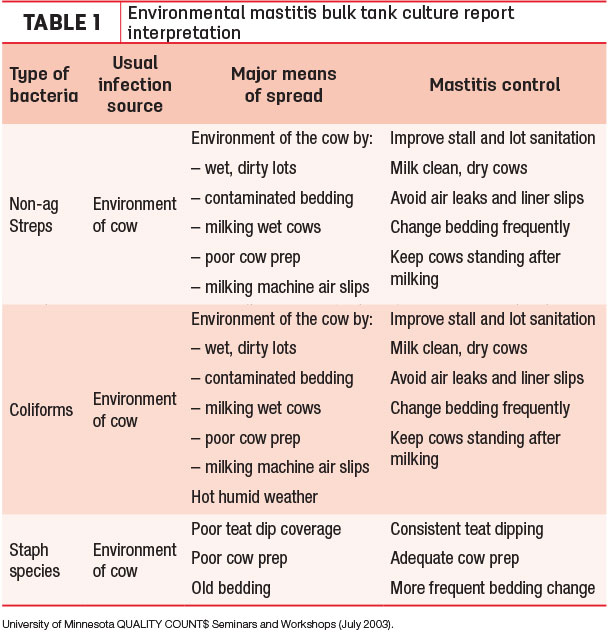Two hundred and 50 dollars. That’s what a single case of clinical mastitis could be costing you. If you’re like most dairy farmers right now, you could find many uses for an additional $250.
Mastitis continues to be the costliest dairy cattle disease. Many farms are successful at controlling contagious mastitis and consistently produce low-somatic cell count milk. However, clinical mastitis is still a challenge.
Clinical mastitis symptoms appear fast and can range in severity score from mild (1) to moderate (2) or even severe (3). Visible abnormalities include udder swelling, hardness of the affected quarter, pain, watery milk, flakes and reduced milk yield. In mild cases, milk will appear abnormal.
In moderate cases, in addition to abnormal milk, you’ll also see physical udder changes like swelling and hardness. In severe cases, cows may also be systematically affected by fever, dehydration and can go off feed.
Five main factors contribute to mastitis: the environment, micro-organisms, management, people and the cow.
Environmental mastitis
Environmental mastitis accounts for one-third of all infections on a dairy. A single clinical case can cost $250 to $300.
The remainder of infections are contagious – spread from cow to cow. On most dairies, as you get a handle on contagious mastitis, you’ll typically see more environmental mastitis, which often appears in clinical cases. Treatment protocols that work for clinical cases aren’t always as effective for environmental cases. Since treatment can be more challenging, prevention is the key strategy.
When does environmental mastitis occur?
Environmental pathogens are more common than contagious pathogens in North American dairies. You’re more likely to experience clinical mastitis with cows in early lactation, during peak milk or hot weather. A cow’s susceptibility to pathogen exposure is highest after dry-off and before calving.
You could also be experiencing a low somatic cell count – less than 200,000 or even 100,000 – with a level of clinical mastitis cases in your herd. Environmental mastitis is more likely to strike when your somatic cell count is lower because there are more opportunities with less challenge from contagious organisms.
How to reduce environmental cases
Identifying the pathogen source is key to controlling environmental mastitis. A cow’s teat is the best collector of what’s in its environment that could be causing mastitis. Anything that comes in contact with the cow’s teat could be exposing it to mastitis-causing organisms.
Taking bulk tank cultures can be a great starting point to find the source of environmental mastitis. If you’re already doing this, take the time to evaluate the results and identify trends. Then, culture your clinical cows and look for primary contributing organisms.
Compare all culture results to troubleshoot and identify the most prevalent mastitis-causing organisms. Commonly found organisms include E. coli, klebsiella and environmental streps. By knowing which organisms you’re dealing with, you’ll be able to properly diagnose and put together a plan of action to prevent environmental mastitis.
Think beyond the cow
After analyzing your bulk tank cultures and individual cow cultures, start thinking beyond the cow. (Table 1)

-
Housing – Consider all housing areas: freestalls, bedded packs, calving pens, dry cows, heifer pens and pre-fresh pens. How clean is the environment? How dry is the environment? What are the air quality and ventilation like? How clean are the cows?
- Bedding – What type of bedding do you use? How often do you bed and groom stalls? Are you culturing your bedding? If so, when did the culture take place? It is important to culture before the stalls were bedded to see how high the bacteria levels get. If you use sand, be sure to test the level of organic matter. Consider moisture level, organic level, bacteria level and amount of bedding. See if the prevailing mastitis-causing organisms match the primary organisms causing you clinical mastitis.
A good goal for bedding bacteria counts is to maintain coliform and environmental streps below 1 million colony-forming units per gram each and under 2 million colony-forming units total. The more time there is between adding fresh bedding, the higher the bacteria level.
- Milking facility – How clean are cow teats? Are you using a pre-dip that successfully kills your top mastitis-causing organisms? Are the parlor and milking equipment clean? Have you cultured udder towels? How long after post-dip do cows lie down? When viewing teats just before udder preparation, how much bedding is stuck to the teats? Are liner slips greater than 5 percent?
If you’re using bedding that easily sticks to teats, such as manure-digested solids or sawdust, dip drying time is especially important when making a post-dip selection.
Some general tips to help control environmental mastitis are:
- Keep cows’ udders, feet, legs and flanks clean at all times.
- Use consistent and effective pre-milking cow preparation.
- Reduce levels of bacteria in bedding materials.
- Scrape alleys three times per day.
- Pay close attention to cleanliness of dry cows and their housing.
- Control exposure to environmental pathogens between milkings for proper udder hygiene.
- Properly maintain bedding material to prevent udder infections and to help reduce somatic cell count.
- Carefully select bedding materials.
- Limit overcrowding.
- Clean maternity pens after each calving – if possible.
- Be proactive in environmental mastitis prevention; treatment is not a viable long-term solution.
Set goals and monitor
To keep clinical mastitis in check, strive for an infection rate of less than 2 percent of milk cows per month and less than 1 percent in the hospital at any given time. Some general management practices to help reach this goal include:
- Reduce the number of bacteria to which the teat end is exposed.
- Improve cleanliness of cow environment, especially in late dry period and at calving.
- Improve pre-milking procedures to ensure clean, dry teats.
To reduce new cases of mastitis, set a goal to reduce clinical cases and new infections (less than 200,000 somatic cell count previous test, greater than 200,000 current test).
Once you have goals set, continue to track and evaluate your performance each month. Charting your goals will allow you to closely monitor progress and determine if you need to implement changes.
Managing environmental mastitis on your dairy can be a challenge. Work with your milk quality and hygiene specialist to stay ahead of it. ![]()
References omitted but are available upon request. Click here to email an editor.

-
Keith Engel
- Dairy Farm Hygiene and Supplies Specialist
- GEA
- Email Keith Engel







